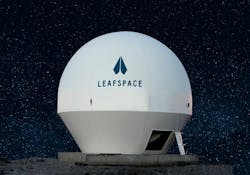Sateliot Boosts 5G NB-IoT NTN Constellation with Four More Nanosatellites
What you’ll learn:
- Insight into Sateliot’s 5G NB-IoT nanosatellites.
- How the nanosatellites function with Leaf Space’s GSaaS stations.
On August 16, 2024, Sateliot, a Barcelona-based startup, launched four additional nanosatellites to expand its constellation of 5G NB-IoT nanosatellites to extend cellular and IoT coverage to anywhere on the planet. Those additional nanosatellites will help boost Sateliot’s goal of operating a constellation of over 100 satellites by 2028, providing the groundwork for global connectivity.
Sateliot has already integrated its 5G NB-IoT nanosatellite stack with Leaf Space’s Ground Segment (see figure) as a Service (GSaaS) Network, which has stations deployed in 16 locations around the globe, with more planned in the coming months. Leaf’s GSaaS stations take advantage of the company’s Network Cloud Engine (NCE), a kind of autonomous bridge that connects terrestrial hardware with satellites in low Earth orbit (LEO).
The NCE functions using microservices running in the cloud to orchestrate the entire activity of the Ground Station Network using a single interface that customers can use to connect to 5G services no matter the cloud service provider (CSP). What’s more, the NCE doesn’t depend on any one active GS or satellite, suiting it for use with any provider.
“We are thrilled to support Sateliot’s 5G NB-IoT satellites in orbit,” said Jonata Puglia, CEO of Leaf Space. “Our global network is performing at its full potential and is ready to support satellites during the upcoming Transporter-11 launch and the commencement of their IoT services.”
Sateliot’s 5G NB-IoT nanosatellites are the first to fully implement GSMA and 3GPP standards. They can connect with any standard cellular narrowband IoT device compliant with 3GPP’s Rel.17 without the need for gateways.
Sateliot’s technology is already set to connect more than 8 million devices from companies who have already contracted the service, opening the door to any number of industries, including agriculture, logistics, livestock, critical infrastructure management, and more. Sateliot has a long way to go, though, if it wants to compete with SpaceX’s StarLink constellation that boasts some 6,646 nanosatellites in LEO, which accounts for two-thirds of the 10,019 active satellites currently in orbit.
About the Author
Cabe Atwell
Technology Editor, Electronic Design
Cabe is a Technology Editor for Electronic Design.
Engineer, Machinist, Maker, Writer. A graduate Electrical Engineer actively plying his expertise in the industry and at his company, Gunhead. When not designing/building, he creates a steady torrent of projects and content in the media world. Many of his projects and articles are online at element14 & SolidSmack, industry-focused work at EETimes & EDN, and offbeat articles at Make Magazine. Currently, you can find him hosting webinars and contributing to Electronic Design and Machine Design.
Cabe is an electrical engineer, design consultant and author with 25 years’ experience. His most recent book is “Essential 555 IC: Design, Configure, and Create Clever Circuits”
Cabe writes the Engineering on Friday blog on Electronic Design.



